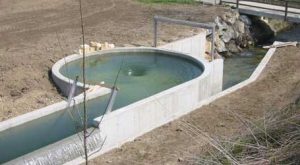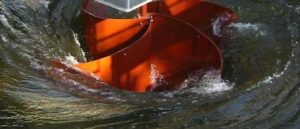Author: Christine Lepisto – “Tree Hugger”
 “While trying to find a method for aerating water without energy input, Austrian engineer Franz Zotlöterer stumbled across the idea of a mini-power plant which is simple to construct and has a turbine efficiency of 80% but which is safe for fish due to low turbine speed and improves water quality by oxygenation. Needless to say, he quickly applied for the patents. The technology can be applied with water drop as little as 0.7 meters. Zotlöterer’s website suggests an idyllic installation along a modern stream that has had its meanders rudely obliterated in the interest of human civilization. His vision is to restore the health of the running water to where it was before human intervention led to reduced oxygenation due to laminar flows–while winning power at the same time.
“While trying to find a method for aerating water without energy input, Austrian engineer Franz Zotlöterer stumbled across the idea of a mini-power plant which is simple to construct and has a turbine efficiency of 80% but which is safe for fish due to low turbine speed and improves water quality by oxygenation. Needless to say, he quickly applied for the patents. The technology can be applied with water drop as little as 0.7 meters. Zotlöterer’s website suggests an idyllic installation along a modern stream that has had its meanders rudely obliterated in the interest of human civilization. His vision is to restore the health of the running water to where it was before human intervention led to reduced oxygenation due to laminar flows–while winning power at the same time.

Zotlöterer describes the many advantages of the gravitational vortex turbine power plant:
At the discharge of the vortex, contaminants are evenly distributed through the water, which is also oxygenated, leading to improved efficiency of natural micro-organisms to decompose the contamints: hence, cleaner water downstream.
The increased contact area between the water and air results in better cooling evaporation during the warm season, and a perimeter of ice insulates the water in the cold season–all the while the turbine continues gently turning out the Watts.
The temperature self-regulation capacity of the water is further enhanced by the concentration of the densest water at the middle of the vortex. Since water is densest at 4°C, water which is warmer than 4°C tends to be cooled when it is pulled into the vortex and cooler water is warmed by the mixing which the vortex causes.* Biodiversity downstream is enhanced by the stabler temperatures.
In the prototype installation, the water drop is 1.6 meters, with a flow of 1.3 m3/second, but the utilized water is 1 m3/s flow with 1.3 meters drop. The vortex basin has a diameter of 5.5 meters. In the first year of operation, the plant has yielded 50,000 kWatt-hours of electricity–with efficiency of around 73%, a little lower than the theoretical 80% achievable efficiency due to the use of smaller generator for ease of operation. The cost for installation was about €40,000 after about 40% subsidy. At close to 1$/watt capacity, that is a sweet point that may make this technology a viable alternative energy. If the claims that the turbine has little negative impact or is even beneficial for wildlife can be supported, this would be interesting for anyone with a home sitting on a hill near a stream. One more arrow in the alternative quiver. If you happen to be passing by Wildgansstraße in Obergrafendorf, Austria, stop by and take a look.
* Such claims make one’s phys-chem truth-o-meter peg the red, but a little mental experiment suggests the claim may be true: imagine the standard stream, flowing in a straight path. The water flows very smoothly, with some “laminar effects” as the water at the bottom is slowed by friction with the streambed and subsequent layers above are slowed by friction with the next lower layer. The densest water (4°C) sinks to the bottom in this model, and the temperature gradient from the bottom to the top of the stream reduces the heat exchange efficiency of this “warm” bottom water with the air-cooled surface layer. Any TH eco-modellers have feedback on the benefits/disadvantages of promoting vortex activity along streams, or the effect such a turbine might have on fish?”
Resource: https://www.treehugger.com/renewable-energy/gravitational-vortex-power-plant-is-safe-for-fish.html

2 Comments. Leave new
Like!! Really appreciate you sharing this blog post. Really thank you! Keep writing.
Thank you for visiting our website. We are keep working to improve it. Stay Tuned!
Kindest regards.